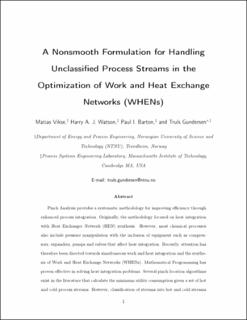| dc.contributor.author | Vikse, Matias | |
| dc.contributor.author | Watson, Harry AJ | |
| dc.contributor.author | Barton, Paul I | |
| dc.contributor.author | Gundersen, Truls | |
| dc.date.accessioned | 2020-03-25T10:08:12Z | |
| dc.date.available | 2020-03-25T10:08:12Z | |
| dc.date.created | 2019-08-13T14:45:17Z | |
| dc.date.issued | 2019 | |
| dc.identifier.citation | Industrial & Engineering Chemistry Research. 2019, 58 (22), 9526-9539. | en_US |
| dc.identifier.issn | 0888-5885 | |
| dc.identifier.uri | https://hdl.handle.net/11250/2648517 | |
| dc.description.abstract | Pinch analysis provides a systematic methodology for improving efficiency through enhanced process integration. Originally, the methodology focused on heat integration with heat exchanger network (HEN) synthesis. However, most chemical processes also include pressure manipulation with the inclusion of equipment such as compressors, expanders, pumps, and valves that affect heat integration. Recently, attention has therefore been directed toward simultaneous work and heat integration and the synthesis of work and heat exchange networks (WHENs). Mathematical programming has proven effective in solving heat integration problems. Several pinch location algorithms exist in the literature that calculate the minimum utility consumption given a set of hot and cold process streams. However, classification of streams into hot and cold streams prior to optimization is difficult when integrating compressors and expanders in HENs. Depending on the integration problem, the compression/expansion temperatures can vary greatly in order to fully utilize the heat of compression (or cooling from expansion) in the process. This represents a modeling issue, as classifying the stream identities prior to optimization essentially impose an upper or lower bound on the temperature variable. Instead, pinch location algorithms must be modified to handle unclassified process streams. Different strategies for handling unclassified process streams in exergy targeting and synthesis of WHENs were proposed by Yu et al. This article presents an alternative and more compact formulation using a nonsmooth extension to the simultaneous optimization and heat integration algorithm by Duran and Grossmann in order to handle unclassified process streams. Optimization is performed using IPOPT, and the sensitivities (gradients) are obtained using recent developments in nonsmooth analysis. The nonsmooth extension is tested for WHEN targeting using a number of examples from the literature. | en_US |
| dc.language.iso | eng | en_US |
| dc.publisher | American Chemical Society | en_US |
| dc.title | Nonsmooth Formulation for Handling Unclassified Process Streams in the Optimization of Work and Heat Exchange Networks | en_US |
| dc.type | Peer reviewed | en_US |
| dc.type | Journal article | en_US |
| dc.description.version | acceptedVersion | en_US |
| dc.source.pagenumber | 9526-9539 | en_US |
| dc.source.volume | 58 | en_US |
| dc.source.journal | Industrial & Engineering Chemistry Research | en_US |
| dc.source.issue | 22 | en_US |
| dc.identifier.doi | 10.1021/acs.iecr.9b00611 | |
| dc.identifier.cristin | 1715641 | |
| dc.description.localcode | © American Chemical Society 2019. This is the authors accepted and refereed manuscript to the article. Locked until 22.5.2020 due to copyright restrictions. The final article is available at https://doi.org/10.1021/acs.iecr.9b00611 | en_US |
| cristin.unitcode | 194,64,25,0 | |
| cristin.unitname | Institutt for energi- og prosessteknikk | |
| cristin.ispublished | true | |
| cristin.fulltext | postprint | |
| cristin.qualitycode | 2 | |
